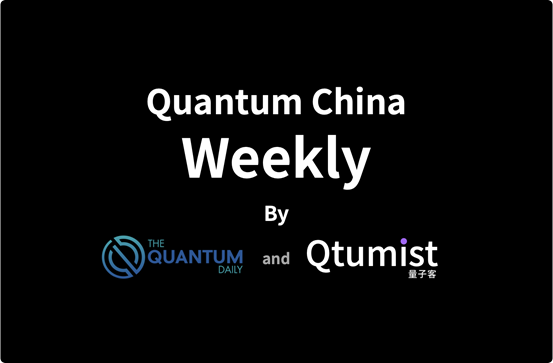
Quantum China is a weekly periodical focusing on China’s quantum information technology, providing a voice for the Chinese quantum technology. It focuses on eight major directions: Policy, Capital, Business, Technology, Research, Education, Conference, and People. Providing researchers, Interested parties, and industry pioneers with all the latest developments in China’s quantum field.
Policy
Beijing Releases the Implementation Plan for Building a Global Digital Economy Benchmark City

On August 2-3, the “2021 Global Digital Economy Conference” was held in Beijing and Lhasa, with the theme of “Innovation-led and Data-driven – Building a Global Digital Economy Benchmark City”, and the “Implementation Plan of Beijing on Building a Global Digital Economy Benchmark City” was released. The plan proposed that Beijing should lay out the leading generation of digital technology innovations, including 6G network, quantum technology, algorithm innovation, blockchain and accelerating the integration of biology and information technology.
Business
ZCWei Quantum passed the CMMI3 international assessment and certification
ZCWei Quantum has passed the CMMI3 (Capability Maturity Model Integration For Software) international assessment and certification. It marks that ZCWei Quantum has been among the advanced level in the industry in terms of standardized process, process management capability and project management capability, and also marks that the company’s internal system construction and operation management level can match the international standard.
Origin Quantum established Science and Technology Association
On August 4, Origin Quantum established a science and technology association, with General Manager Zhang Hui as the chairman of the association, and said that the establishment of an enterprise science association can open up innovation for the company’s technological development; fully enhance the quality of employees and the team’s scientific research atmosphere; promote the exchange and cooperation between enterprises and enterprises, universities and research institutes; and at the same time safeguard the legitimate rights and interests of scientific and technological personnel.
China Computer Federation establishes “CCF Quantum Computing Specialty Group”
The China Computer Federation (CCF) has established the CCF Quantum Computing Specialty Group and is seeking applications from all CCF members to serve as executive members of the group and to run for the position of specialty group leader. The deadline for applications is 24:00 on August 20, 2021.
Technology
Origin Quantum Releases Quantum Artificial Intelligence QGAN Application
Based on its self-developed quantum machine learning framework VQNet, Origin Quantum has verified the feasibility and effectiveness of QGAN algorithm on its quantum operating system Origin Pilot, combined quantum generative adversarial network technology with image restoration, and realized the application of portrait restoration on QGAN.
Online experience address:https://qcloud.originqc.com.cn/main/QGAN
Research
QuantumCTek and others have completed the live network verification of the “QKD+PQC” fusion availability
A joint team of QuantumCTek, USTC, CAS Quantum Net, Jinan Institute of Quantum Technology and Shanghai Jiaotong University has completed the first international network validation of the fusion of quantum key distribution (QKD) and post-quantum cryptography (PQC). The study demonstrates that the “PQC+QKD” fusion scheme can effectively adapt to the interactive communication conditions of large-scale networks and is feasible in practical applications, providing a convenient new means for large-scale authentication of QKD devices and laying the foundation for further research and application of the fusion technology. The study was published in academic journal Optics Express.
Paper:https://doi.org/10.1364/OE.432944
Kunfeng Quantum releases research results for color image classification problem
Kunfeng Quantum has proposed two quantum lines, HQconv and FQconv, and the prediction accuracy of the hybrid quantum neural network built with these two lines surpasses that of traditional convolutional neural networks with similar structures on a small CIFAR-10 dataset. The line can extract effective image features for image classification, which provides a feasible solution for quantum computers to better solve common AI problems. The related research has been published in arXiv.
Paper:https://arxiv.org/abs/2107.11099
USTC and other research teams make important progress in the study of kagome structured superconductors
A joint team consisting of USTC, CAS, and HeFei National Laboratory For Physical Sciences At The Microscale observed the coexistence of three-dimensional charge density waves and superconductivity in the kagome superconducting CsV3Sb5. And signs of Majorana zero-energy mode were found in the superconducting magnetic flux core. This study shows that the kagome material is one of the ideal candidate systems for studying topological superconductivity. Related research was published in Physical Review X .
Paper:https://journals.aps.org/prx/pdf/10.1103/PhysRevX.11.031026
USTC realizes use the quantum system to find the zero point of Riemann function
The Guo Guangcan team of the USTC with Spanish theoretical physicists used the quantum state of the trapped ion to be periodically driven, and successfully measured the Riemann function experimentally. The first 80 zeros. This discovery provides an important experimental basis for studying the Hilbert and Pólya proposal and understanding the relationship between the Riemann conjecture and quantum systems. Related research was published in NPJ Quantum Information.
Paper:https://doi.org/10.1038/s41534-021-00446-7
If you found this article to be informative, you can explore more current quantum news here, exclusives, interviews, and podcasts.















